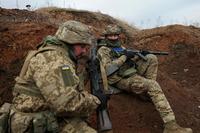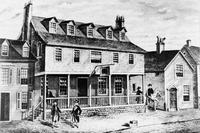Air Force maintenance teams are pulling a decommissioned B-1B Lancer bomber out of the boneyard and plan to put it back into active-duty service to replace another Lancer that was damaged in a fire.
The resurrected aircraft, nicknamed "Lancelot," was retired to the 309th Aerospace Maintenance and Regeneration Group at Davis-Monthan Air Force Base in Tucson, Arizona, also known as the boneyard, almost three years ago, according to a photo caption of the aircraft in a news release.
The decision to dust off "Lancelot" and get it back into service was made following an April 2022 incident at Dyess Air Force Base in Texas, in which another Lancer caught fire during "routine maintenance," the base said at that time. An accident investigation board report said the fire caused nearly $15 million in damage to the aircraft.
There is a congressional mandate to have an operational Lancer fleet of a certain size, but Air Force officials opted to recommission the retired bomber instead of restoring the damaged plane, given the extensive and expensive repairs that would be necessary.
"With projected repair costs to fix the fire-damaged aircraft expected to be cost-prohibitive, Air Force officials elected to regenerate 'Lancelot,'" the service said Thursday in a press release.
A team with members from the 309th AMARG, Dyess' 7th Bomb Wing and Tinker Air Force Base's 76th Expeditionary Depot Maintenance Flight and 569th Egress Flight has been working to put "Lancelot" back into service, according to the news release.
They got the retired Lancer into a flyable state so it could make it to Tinker Air Force Base in Oklahoma, where it will undergo more repairs.
The B-1B airframe has been in service with the Air Force since the mid-1980s; about 60 are left in the fleet, which is divided between Dyess in Texas and Ellsworth Air Force Base near Rapid City, South Dakota.
Each of the bombers is valued at approximately $317 million, according to a service fact sheet. The long-range bomber hasn't been nuclear-capable since 2007.
"The United States eliminated the nuclear mission for the B-1 in 1994," the fact sheet detailed. "Even though the Air Force expended no further funding to maintain nuclear capabilities, the B-1 was still considered a heavy bomber equipped for nuclear armament until 2007."
Between 1984 and 2021, the latest data available from the service, officials recorded a total of 29 Lancer Class A mishaps -- the term used for the military's deadliest and most expensive incidents -- in which 11 people died.
Most recently, on Jan. 4, a B-1B on a training mission with a crew of four crashed while trying to land at Ellsworth with another Lancer. The first bomber landed successfully, while the second crashed.
All four crew members safely ejected and received medical care. The runway was closed for a month due to the damage, and some Lancers and crews were temporarily relocated to Dyess in the interim.
In late 2022, the Air Force unveiled its latest bomber, the B-21 Raider, marking the first new bomber in the American military's fleet in more than 30 years. Officials are hoping it will eventually replace both the Lancer and the B-2 Spirit bombers sometime in the 2030s.
The Pentagon plans to acquire around 100 B-21s, more than the Air Force's current B-2 and B-1B Lancer fleets combined, with an average unit cost for each bomber of nearly $700 million, according to a service fact sheet.
Related: South Dakota Air Force Base Stops B-1B Lancer Flights Following Runway Crash












